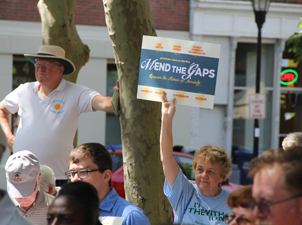
Our Challenging National Reality
Facing Our Failure to House Everybody
Simone Campbell, SSS
November 24, 2017
I live in Southwest Washington which 13 years ago when I moved in was an undiscovered portion of the District. Rents were affordable. There are housing projects across the street. It was a great multiracial, economically diverse part of town. Then development started with the Nationals’ baseball park and high rise luxury condominiums. When I moved in I had a clear view of the palisades on the other side of the Anacostia River. Now we are being hemmed in with construction of unaffordable condos. This has me worried. Where are low wage working families going to live?
This is not only a DC phenomenon. All of the cities I have visited have the same story. In Indianapolis at the Immigrant Welcome Center’s GED class, I heard of low wage working families being evicted from houses so the owners can sell them to developers. It was impossible for these families to find housing in their old neighborhood and they had to move out of the city.
In Cincinnati’s Over-the-Rhine neighborhood, I was shocked when I visited last year for the first time since 2012. The neighborhood is completely changed. New construction and restored historic buildings line the street. When we met with trainees at Venice on Vine restaurant in the old neighborhood, they spoke of how their community had changed. They were no longer able to live in the area. Services for low income families had moved to other areas. It was difficult to commute because public transit is so spotty and set up for the “old city” not the new reality.
In Milwaukee I met Billy and his wife who, after trying to live with their two sons in their car, decided to pool their salaries for rent and use food stamps and the free dining room at St. Benedict the Moor parish to feed their family. In San Jose, CA, the heart of Silicon Valley, I met parishioners who open their church parking lot/school playground every evening so that homeless families can park their car in a safe place for the night. Almost all of these “car families” have working parents.
In short, our neighborhoods are transforming before our eyes, and our housing policy cannot handle the current reality. We at NETWORK realized that if we are going to Mend the Gaps in income and wealth disparity, we must address housing policy. There needs to be a new burst of creativity to impact this twenty-first century reality.
Housing is one of those critical issues that has so many ripple effects. The value of housing stock affects property taxes and the amount of money available for local schools. Housing also affects the need for public transit and the ability to be near work. Urban housing policy affects the amount of “green space” and the sense of safety and serenity in a city. Housing affects the ability of families to live free from the fear of being homeless. In short, housing is at the heart of the health of our nation.
In the United States we pride ourselves on being problem solvers. However we are failing our communities on this housing dilemma. First we must begin to pay attention to what is actually happening in our cities, towns, and neighborhoods. Watch for both creative ideas and continuing problems. Talk to your neighbors and asked your local and federal representatives what they are doing to address our lack of safe, affordable housing.
And hold this issue in your reflective prayer. Let us ask the Spirit the question: “Where are you calling us to act in addressing the housing crisis?” Then share with us what you hear. I believe it will be like Elijah who waited for the word in the loud bluster, thunder and lightning and heard nothing. It wasn’t until the gentle breeze that the word of the Spirit came. Let us as a community be attuned to that “wee small voice” so we might find the way forward for the sake of our struggling family.
Originally published in Connection Magazine. Read the full issue here.







